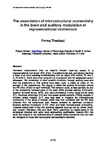The association of microstructural connectivity in the brain and auditory modulation of representational momentum
| dc.contributor.author | Theobald, E. | |
| dc.date.accessioned | 2019-05-17T11:22:22Z | |
| dc.date.available | 2019-05-17T11:22:22Z | |
| dc.date.issued | 2015 | |
| dc.identifier.citation |
Theobald, E. (2015) 'The association of microstructural connectivity in the brain and auditory modulation of representational momentum', The Plymouth Student Scientist, 8(2), p. 179-199. | en_US |
| dc.identifier.issn | 1754-2383 | |
| dc.identifier.uri | http://hdl.handle.net/10026.1/14103 | |
| dc.description.abstract |
Perceived displacement from an object’s forward trajectory results in a representational momentum (RM) effect. In a behavioural task, participants watched a video of an actor reaching for/withdrawing from an object after hearing ‘I’ll take it’ or ‘I’ll leave it’, which was either congruent or incongruent with the subsequent action witnessed. The knowledge of other people’s intentions through auditory cues and then the predictions of their actions have been found to create an effect on the strength of RM experienced. The degree to which this auditory information affects the RM effect differs for each individual. This variation could, at least partially, be due to the connectivity between parts of the brain which process auditory information, superior temporal sulcus (STS), and parts processing moving visual stimuli (area MT). Fractional anisotropy (FA) and tract-based spatial statistics (TBSS) analysis of diffusion tensor imaging (DTI) data was used to measure the microstructural connectivity of the areas of interest, which was then correlated with the RM data collected from the behavioural task. Results revealed no significant correlation between auditory modulation of RM effect and brain microstructural connectivity. However results were in line with previous research such as that by Kerzel (2005) and Hudson, Nicholson, Ellis and Bach (2015, submitted) by results being in the anticipated direction and some were approaching significance. Results from this study are integral to our understanding of people’s social perception and can help aid therapies for those with neurological and psychiatric disorders. | en_US |
| dc.language.iso | en | en_US |
| dc.publisher | University of Plymouth | |
| dc.rights | Attribution 3.0 United States | * |
| dc.rights.uri | http://creativecommons.org/licenses/by/3.0/us/ | * |
| dc.subject | representational momentum | en_US |
| dc.subject | behavioural task | en_US |
| dc.subject | superior temporal sulcus | en_US |
| dc.subject | Fractional anisotropy | en_US |
| dc.subject | tract-based spatial statistics | en_US |
| dc.subject | diffusion tensor imaging | en_US |
| dc.subject | psychiatric disorders | en_US |
| dc.subject | neurological disorders | en_US |
| dc.title | The association of microstructural connectivity in the brain and auditory modulation of representational momentum | en_US |
| dc.type | Article | |
| plymouth.issue | 2 | |
| plymouth.volume | 8 | |
| plymouth.journal | The Plymouth Student Scientist |



